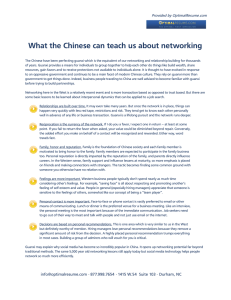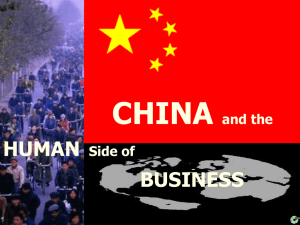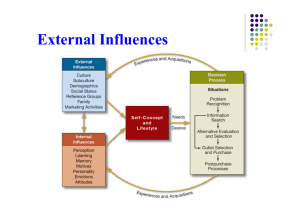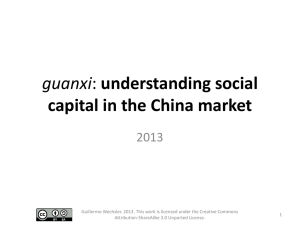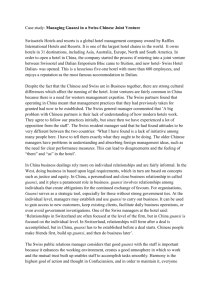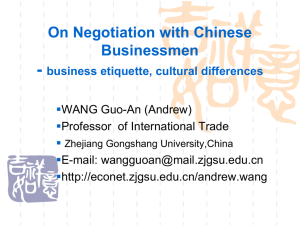Alex Shum December 2007 Senior Thesis Seminar
advertisement
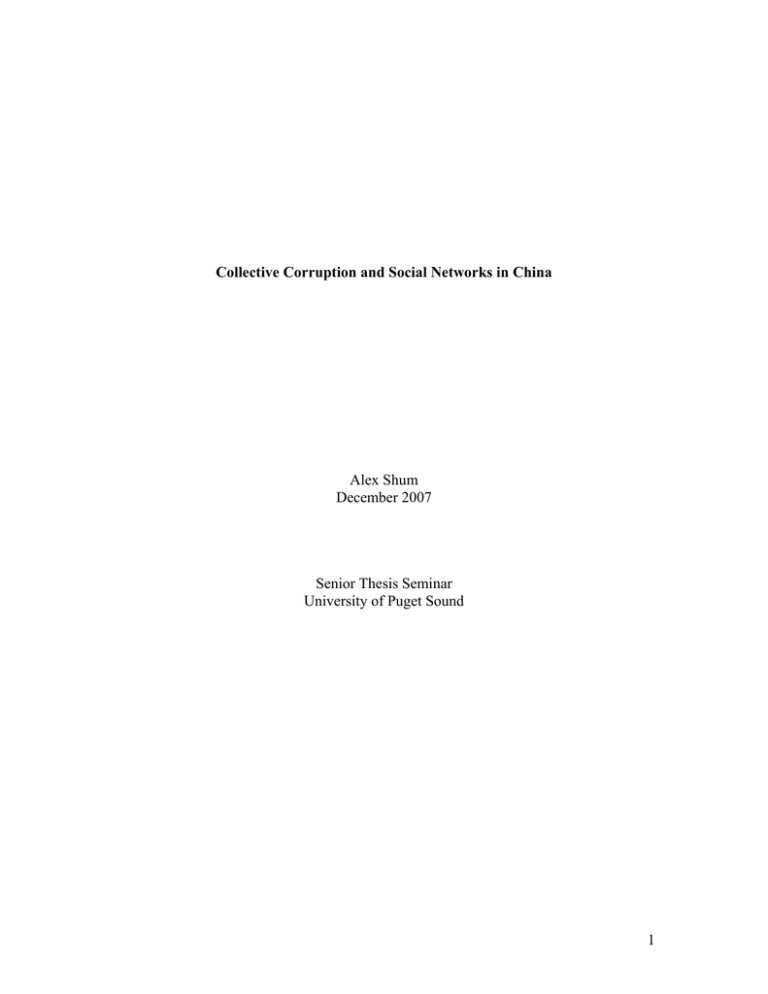
Collective Corruption and Social Networks in China Alex Shum December 2007 Senior Thesis Seminar University of Puget Sound 1 I. Introduction According to Transparency International in 2006 out of the 30 major exporters in the world, China was ranked the second worst in terms of bribery (Transparency International, 2006). Not surprisingly, as a response to the massive amount of corruption China has developed business practice around a system of personal relations and mutual obligation. This is called ‘guanxi’ in Chinese or literally connections. What is often seen as simple bribery or cronyism is acceptable business practice in China among both private businesses and the government (So and Walker, 2005). While guanxi can be used for explicitly illegal purposes, it can also be used to improve relations between businesses and as a result it is sometimes difficult to determine the legality of guanxi. The institution of guanxi networks at its most basic level can be defined as interpersonal connections between people who share a group status, geographical location or are related to a common person. However, guanxi can also exist between frequent business associates or persons introduced through someone else in the network (Fan, 2002). These connections between people are in turn often used for business. Many Chinese are especially risk averse in their business relationships and prefer spending significant amounts of time and money establishing connections; it is the time and money spent building and maintaining these social networks that truly defines guanxi (So and Walker, 2005). One way to increase one’s own network is to give gifts. By accepting gifts or services the involved person is obligated to perform an undefined service in the future. The World Bank and the OECD consider many of these transactions bribery and it is also true that many people in China openly accept bribes and use the guanxi label to try and legitimize their activity. The main difference in many of 2 these cases is that the emphasis is on building relationships and the gift giving is not a fee-for-service bribe; many other countries often have well known ‘prices’ for such commodities as import licenses or construction contracts (Schramm and Taube, 2003) This paper examines the incentives created by guanxi networks. Giving the current conditions of missing institutions and corruption in China, guanxi networks offer a transaction cost reducing solution to both domestic and foreign businesses operating in China. The Chinese government’s lack of oversight in operational procedure allows for government officials at all levels to abuse power. Extortion from the government as well as bribes to bend laws are both commonplace. Normally this would lead to a prisoner’s dilemma scenario between businesses and government; however guanxi networks alter the incentives to cooperate in the long run. Incentives between businesses are also improved by guanxi networks because trust and long-term relationships are at the center of guanxi. II. Guanxi Social Networks Using social networks as business connections is hardly unique to China; many former communist states have similar networks. This is partially due to conditions of shortages and a state system of favoritism. Russia, for example, also has similar social networks called blat (Michailova and Worm, 2003). As previously noted social networks like guanxi in China are much more than simple bribes; they are a system to insure continuity of relationships and trust. For example, suppose in the following scenario person A needs a favor and he asks person B, a member of his network. Person B is obligated to help person A and if he cannot he will pass this request on to person C. Thus, even though person A does not know person C directly they are under obligation to help 3 each other through person B. In this case, both person A and person B are indebted to person C. Guanxi also involves many other activities that are meant to build trust among people in the guanxi network; such activities include having meals together, gift giving, visiting an associates place of business, hiring the offspring of an associate or doing a favor for them in a time of need. Guanxi cannot be built with one time bribes; many individuals spend years building these networks of connections and view them as social capital (Dunfee and Warren, 2001). Since guanxi are relationships at the individual level businesses can only use guanxi through their employees. If an employee leaves his job, his former company will lose access to his contacts as well. This is sometimes a concern with businesses because the resources spent building guanxi are very high. Building guanxi does not simply mean a small meal or gift every few years; households will typically spend between 10% and 20% of disposable income for strengthening guanxi networks. The Hong Kong Independent Commission Against Corruption determined that businessmen spent five percent of investments in mainland China solely on gifts to maintain guanxi networks (Schramm and Taube, 2003). In addition to monetary costs there is also the time cost of building and maintaining guanxi networks. To truly build close connections to business associates, you must also show concern over their personal lives outside of business deals (Fan, 2002). Guanxi relationships can be broadly categorized into two areas: business to government relationships and business to business relationships (Fan, 2002). Guanxi relations between the business and government is often associated with corruption and is when a business person uses his or her guanxi connections to someone in the government for gain. Business to business relationships are relationships between two companies that 4 have a favored status with each other. The two types of relationships are analyzed separately in the following sections. III. Business to Government Relationships In the early 1990s Lai Changxing was able to set up a successful smuggling business in the port town of Xiamen located in southeastern China (Menshausen, 2005). The front of his company was registered as an electronics import company and when he formed the company he invited many provincial and city leaders, high level customs officials, tax officials and directors of the state-owned banks to an expensive banquet. He also spent much time establishing good relations by giving “hongbao”; hongbao are red envelopes containing money given during festivals and are sometimes used to disguise bribes. In addition throughout the 1980s Lai had been a restaurant owner and had built up good connections with the head of the public security bureau in the province as well as with the head of the customs in the town by often treating the two to free dinners at his restaurant. In return for these gifts officials in Xiamen overlooked the fact that Lai’s company did not have any permits to import goods, tax officials provided fake receipts for tax purposes, the state-owned banks provided letters of credit, and harbor authorities let his cargo pass without inspection. His company was even directly shielded from investigation by the vice-minister of public security. Lai Changxing took advantage of his connections to protect his illegal business from government prosecution; in addition he used his connections to avoid such costs as import permits and taxes. These guanxi networks are able to operate in such a manner because of the system setup by the Chinese Communist Party in which the party has the ability to override legal and regulatory 5 constraints (Lieberthal, 2005). Since the rule of law is weak in China, who you know is much more important than regulations and what you know. While guanxi connections can be used to bend laws, they can also be used to protect businesses from extortion by corrupt government officials. One private company in China hired the son of a government official as an administrative assistant in order to use his father’s connections as protection (Xin and Pearce, 1996). The tax auditing bureau decided to audit this company for tax fraud; in China there are no standardized rules on how to keep financial records and the auditing bureau has a lot of power in finding fault with tax records. If the company was found guilty of tax fraud they would face thousands of RMB in fines and potentially lose their business license. The head of the company called in the government official’s son. The official’s son setup a lunch with the tax auditors. After drinks and food at an expensive restaurant the head of the accounting department praised the company on its efficient accounting system and all charges were quickly forgotten. Building good relations with local government officials is vital for businesses in China. Poor relations with local officials will not only mean the possibility of extortion but also the possibility government services will be denied. Basic services such as running water and electricity can be shutoff. In addition, since the banks in China are state owned, gift giving to the right officials can change the eligibility of a firm in seeking loans. Guanxi networks can often act as substitutes for formal institutional networks. In countries without strong legal or regulatory environments abuse of power is common and personal connections are substitutes for reliable government and the rule of law. This was an example of how a private business used guanxi connections to lower costs of 6 extortion by government officials. A study by Xin and Pierce (1996) finds that unlike state-owned companies, private companies are more likely to report that their business connections are useful as a defense against threats and will generally report more connections with individuals in government positions. Private businesses often resort to guanxi networks because corruption in the government is still widespread in China and the power structure of the Chinese government allow for certain individuals to accumulate unchecked power. Although some officials are periodically arrested and given exemplary punishment, the central government in China has only made a halfhearted attempt at cracking down on corruption (Lieberthal, 2005). One of the major problems is that oversight mechanisms are not independent; in fact they are often subordinate to local officials they are tasked to watch (Sun, 2005). Furthermore, officials at every level have a large degree of autonomy. Every official is highly vulnerable to those above but, at the same time, can act like a dictator toward those below. Punishment is unlikely in this type of bureaucracy because the officials are able to skew information that goes onto higher levels (Lieberthal, 2005). While having connections to people inside the government can be a deterrent against extortion it can have other benefits as well. The chairman of an Australian company seeking investment opportunities in China was a close friend with the local executive of a state-owned enterprise (Fan, 2002). In turn, this executive was close friends with key government officials. Throughout the entire negotiation process the local executive was able to relay information on how the government viewed the Australian company’s project. The chairman of the company was able to adjust his project accordingly and his project was successful. Guanxi relationships can have other 7 positive effects as well such as acting as a shortcut through government bureaucracies and even limiting government inefficiencies. During the era of state planned economy, China faced many shortages in consumer goods. The use of guanxi relationships could allow for citizens to obtain hard to find consumer goods (Michailova andWorm, 2003). If the government sets up a queue system for access to a rare commodity, individuals with guanxi connections are able to pay for a better position in the queue. By having friends in government willing to allow this type of deal a more efficient solution is reached; people who value the rare commodity are willing to pay extra for it (Lui, 1985). Business to government guanxi relations are also defined by the imbalance of power between the two sides. While the government has both the power to punish or aid the business, with the correct relationship they can both benefit. IV. Modeling Business to Government Relationships The relationship between an abusive government official in a position of power and a private business in a one-time game is modeled in figure 1. Assume that the cost of the bribe is lower then the extortion cost (c < e); if the cost of the bribe was higher than the cost of extortion than the business would prefer getting extorted rather than to pay a bribe. Since we know that businesses would rather pay a bribe to stop extortion we must assume the cost of the bribe is lower than the cost of extortion. In addition the cost of the bribe must be equal or greater than the fraction of extortion gained by the government officials, otherwise the government officials would much rather extort than to bribe (c => p(e)). Finally, it should be noted that the fraction of extortion gained by corrupt government officials is less than the full extortion cost incurred by the business (p(e) < e). When a corrupt government official decides to extort the business, the cost of extortion 8 incurred by the business does not always equal the amount gained by the official because some of the extortion tactics that the officials employ are not necessarily money based and it is costly to extort. Although the chance of punishment is quite small since the actual punishments are quite severe, the government officials still do factor in the expected outcomes. According to Chinese law, accepting an amount of more than 100,000 RMB can result in anywhere from 10 years to life imprisonment or the death penalty along with confiscation of property. Punishment is increased when the officials actively demand a bribe (Menhausen, 2005). Keep in mind the tax auditing case in China: if the auditing officials reported tax fraud the company would face fines and could lose their business license. The corrupt officials will earn nothing from a business losing their license but the cost of losing a license is a big cost for the business. Other extortion techniques, depending on the level of corruption of the officials, include inflating fines and pocketing a portion of the money or even the possibility of not reporting cases to higher authorities and pocketing all of the fines charged to businesses. The business can choose between bribing the government or not bribing and simultaneously the government can choose between extorting and not extorting. It is possible for the government official to be opportunistic and extort even after accepting bribes (bottom left cell) and also possible that the government official will be honest and not extort at all even without the business paying a bribe (top right cell). When the business does not get extorted and does not offer a bribe, the business keeps all of its own profits and the government official gets no payoffs (top right cell). If the business offers a bribe and the official decides not to extort then the business gets to keep profits minus the cost of the bribe and the government officials get the full value of the bribe (bottom right cell). The 9 final possible outcome is for the businesses to not offer bribes and the officials to extort the business (top left cell). In this simultaneous one-shot game the business is always wiser to not offer bribes and the official’s dominant strategy is to extort because the business’s bribe will not necessarily stop corrupt officials from engaging in opportunistic behavior and the officials have no disincentive to extortion. This is a case of the prisoner’s dilemma; the government officials and the business owners are collectively better off with the officials not extorting and the business offering bribes, but because the incentives against bribing and the incentives for extorting it is in both parties’ self interest to not cooperate. The Nash equilibrium is for businesses to not offer bribes and for the government officials to extort the business. Since this is a one-time game, there is nothing stopping the government from continuing to extort the company even after accepting bribes. Similarly if the government decides not to extort the business there is a chance the business will not offer bribes to the officials and they will get nothing. When guanxi networks are added to the game the payoffs will change slightly because of the emphasis on building long term relationships. 10 A repeated game is represented in figure 2. Businesses are now separated between those who have guanxi connections and those who do not have connections. Similar to the previous model it is assumed the extortion cost is bigger than the cost of bribe otherwise firms would prefer extortion (c < e). Additionally, the value of future guanxi is worth more than fraction of extortion and also worth more than the gain from bribe (p(e) < f and c < f respectively). From the business’s point of view guanxi is not only a deterrent against future extortion but also the lowering cost of information, and perhaps discounts on bureaucratic licenses, availability of loans and the easing of regulatory laws. From the point of view of the corrupt government official this means regular gifts from businesses. The payoffs for a business with no connections in this example are the same as businesses who decide not to bribe the government in the previous example of a one shot game. If a business uses its connections it will incur the cost of the bribe, or in this case the cost of using connections. If the government does not extort the business and the business offers a gift to the officials the business will build 11 guanxi and establish a better relationship with the government officials in the future (bottom right cell). As previously stated good relations with local officials is more important in China than in many other places in the world because of the power structure of the government and the amount of autonomy local officials are given. This was the case with smuggling in Xiamen; Lai Changxing was able to obtain tax exemptions and loans from government banks and also bent the law in his favor. Another possibility is that the business uses its connections and the government officials are opportunistic and decide to also extort the company (bottom left cell). In this case the business and the government will both be worse off. The business has to pay for trying to establish guanxi and additionally suffers the cost of extortion. The government officials will gain a portion from extortion and keep gifts given in the guise of building connections but will lose guanxi. The loss of guanxi means the officials are forfeiting future gifts and favors given to build guanxi. And if one of the business owners has connections to a more senior official it could mean that this government official will face retribution from above. Another potential consequence is the loss of reputation. If the official acts opportunistically the business with guanxi connections to other people can spread the word about the untrustworthiness of this official. This is harmful to the official in attracting business to the area or detrimental to business relations if the official is involved in a state owned enterprise. There are now two Nash equilibria in this repeated scenario. The first equilibrium is the one where the government officials extort businesses that do not have connections and the businesses will not use their connections. The second equilibrium is the one where the officials will choose not to extort the businesses and simultaneously the 12 business will choose to use their connections. The businesses with no connections will be facing many more bureaucratic obstacles. There are fewer incentives for government officials to not extort these companies. These companies can try to bribe the officials but as we saw in the first example this does not stop opportunistic behavior from the government officials. On the other hand, the businesses with strong guanxi connections to the local officials will be protected from extortion. Opportunistic behavior is protected through social networks; repeated interaction will promote cooperation and both the business and the government officials will be better off. Over time one Nash equilibrium will dominate the other. While there are two Nash equilibria, it is clear that one is more advantageous than the other; businesses prefer to build connections and to not get extorted (bottom right cell) over the other equilibrium of not building connections and getting extorted (top left cell). In this case the bottom right Nash equilibrium is the evolutionary stable strategy; in repeated scenarios the bottom right equilibrium will dominate the top right equilibrium. For example, lets consider a scenario where the entire population consists of either type A, or business people with connections (bottom right equilibrium), and type B, businesses without connections (top right equilibrium). The initial population in this scenario consists of 50 percent type A and 50 percent type B. Over multiple repetitions the population of type A will increase and the population of type B will decrease. This is due to the fact that the expected payoffs are much higher from being type A than type B. Over multiple generations while businesses that are type A will find that they have the optimal solution, type B will either go out of business, choose not to operate in this market or they will come to the conclusion that payoffs are much higher when they have connections to 13 government officials and will attempt to establish guanxi relationships with them. Type Bs have low fitness; they do not survive repeated interactions in this scenario and in the end type As will dominate type Bs. After multiple repetitions of this scenario the population of type As, initially with a population of 50 percent, will approach zero and the population of type Bs, initially with a population of 50 percent, will approach 100 percent. V. Business to Business Relationships Business to business relationships are similar to business to government relations because both are based around the idea that repeated interaction will reduce opportunism and increase cooperation (Glaeser, 2000). However in a relationship between two businesses one side does not have the opportunity to extort money from the other side. Guanxi networks in business to business relationships are more about information and reliability of business partners rather than protection from extortion or assurance of basic services. There are two main issues involved in business to business relationships: 14 uncertainty and opportunism. Guanxi networks are expensive to join and the upkeep costs associated with maintaining positive relationships with business associates is also high and as a result these high costs act as effective tools to reduce uncertainty among businesses as well as minimize opportunism. Guanxi networks can lower transaction costs in the form of contact and control costs. The cost of membership in one of these networks is expensive and opportunistic or unreliable firms will not find it profitable to join. This is because opportunistic behavior will quickly ruin a business’s reputation among other members. In addition the honoring or violation of a contract will also spread quickly in the network and result in a loss of trust among network members. Exclusion from a guanxi network means not only the loss of the cost of establishing guanxi but also the increased cost of future transactions with the members of the network or perhaps the chance that network members will completely refuse to do business with the ostracized business. Once a business has established itself as not opportunistic and reliable, the costs of contact, negotiation and implementation of transactions between network members is reduced (Schramm, 2003). The exclusion of unreliable and opportunistic businesses insures that contracts have a much higher chance of being fulfilled when negotiated with network members. Honoring contracts allows for members of the network to continue engaging in further low-cost transactions with other members of the network. Thus even if two members of the network never plan on engaging in business in the future it is in their best interest to not act opportunistically as business with other network members could be affected. Under guanxi networks maintaining long term business relations is thus more important than short term gains. 15 Membership into these networks is both a type of screening mechanism and signaling mechanism. VI. Modeling Business to Business Relationships Businesses try to interact with non-opportunistic companies. Untrustworthy companies are likely to engage in opportunism including breaking contracts or switching to lower cost competitors. The cost of searching for business partners and negotiating contracts is time consuming so businesses try to avoid opportunistic partners. However businesses do not know if other businesses are opportunistic or not and therefore without some sort of knowledge network they will do business with both. Businesses are not opportunistic with probability (1 - p) and opportunistic with probability (p). If a nonopportunistic business is able to contract with another non-opportunistic business they will both receive a high payoff of (H). If a non-opportunistic business contracts with an opportunistic business than then the non-opportunistic business will incur a cost of the opportunism (-L) and the opportunistic business will gain (L). For a non-opportunistic business seeking an honest company the expected payoff will be [(P*H) – (1-P * L)]. The expected payoff is the expected gain from interacting with a reliable honest business minus the expected loss from interacting with an opportunistic business. However with guanxi networks the reliability of business partners is guaranteed. The addition of guanxi networks in this interaction between two businesses is modeled in figure 3. In this new model two businesses, business 1 and business 2, decide whether or not to set up a business agreement. In this model a high payoff is larger than the gain from opportunism (H > L), the cost of signaling is lower than the high payoff (H > S) and the cost of the signal is higher than the gain from opportunism (S > H). The 16 higher payoff indicates both the possibility for a long term business relationship and the gain in reputation that is required to stay in the guanxi network. Although the gain from opportunism might be higher than the gain from a legitimate business deal in the short run, opportunism eliminates the chance these two businesses will interact in the future and the victimized business will tell others about the questionable practices of the opportunistic business and they will not be able to do business with the rest of the network again. The cost of signaling is high because of the amount of gifts and time required to establish connections to others. Although all of this gift giving might negate any profits from a business deal in the short run, the establishment of connections allows for continued trust in the long run and the reduced search cost for more business partners. Finally, the cost of signaling is higher than the gain from opportunism because the cost of signaling is high and opportunism is a one time gain. If a business establishes a reputation for opportunism after spending money to make many connections the business will not find many willing business partners and will most likely be ostracized by members of the guanxi network. In this model Business 1 will have a probability of (p) to be not opportunistic or a probability of (1-p) of being opportunistic (it is assumed in this model that business 2 is not opportunistic). However, businesses can now send a signal to others about their reliability. The more reliable a business the bigger their guanxi network is; more people are willing to do business with them and they will build a reputation as reliable and not opportunistic. Sending this signal requires joining a guanxi network. Since joining a guanxi network takes both time and money there is a cost of signaling (S). Once the business has decided whether or not it wants to join a network, other businesses can then 17 select whether or not to interact with this business. Regardless of opportunism if the businesses decide not to do business both of them will receive a payout of zero. If business 1 signals but business 2 decides not to do business then both businesses receive zero payout and business 1 also incurs the cost of the signal. If the two businesses are both not opportunistic then they will receive a high payoff of H (minus the cost of the signal if business 1 signals). If business 1 is opportunistic then it will have a short term gain of L and business 2 will incur an expensive of L. In the case of business 1 the gain of L represents the gain from not fulfilling a contract or switching firms; not delivering goods even after payment or switching to a lower cost competitor. For business 2 the loss of L represents the payment of a good without delivery, the cost of searching for a new reliable business partner and the cost of signing a new contract. However, with a guanxi network the possibility with interaction with opportunistic companies is much lower. The high cost of signaling has two effects; it not only makes it not profitable for opportunistic companies to join these networks and it forces companies that have already spent money building connections to continue good business practices to maintain a good reputation. Through utilizing connections a company will only deal with other businesses that signal (are part of the guanxi network). The information about a business’s worthiness obtained through these networks increases the expected outcome of businesses. Originally the expected outcome was the expected gain minus the expected loss. With guanxi networks businesses can now restrict business interactions with nonopportunistic companies. Just as business to government guanxi relationships have a evolutionary stable solution, business to business guanxi relationships also have an evolutionary dominant 18 solution. Businesses that are part of extensive guanxi networks will find it much easier to find business partners. Although unlike the business to government scenario, one solution does not completely dominate the other. It is still possible for businesses that are not in guanxi to find business partners. The game tree in figure 3 allows for the possibility of a business that does not signal (join a guanxi network) to still find business partners. However, businesses that are not part of guanxi networks will have a lot more trouble avoiding opportunism because they do not have the same shared information resources available to members of a guanxi network. In addition, the lack of guanxi can be viewed negatively by others; there is a possibility a business has no guanxi connections because it is unreliable. After multiple generations, businesses with guanxi will dominate those without guanxi. Non-opportunistic businesses that do not have guanxi will slowly build it and opportunistic businesses that do not have guanxi will likely go out of business. The only businesses that remain without guanxi in this scenario are the new businesses that have not had time to build extensive guanxi connections. 19 VII. Conclusion In conclusion guanxi networks are not the most efficient solutions. China would have a much more efficient economy if China had stronger contractual laws, tax codes, a more independent judiciary, and stronger checks on corruption. However, given that China does not have a very strong rule of law, these personal networks are a fairly adequate solution. Although guanxi networks can be abused for illicit gain, guanxi relationships between businesses and government officials can also benefit both sides and reduce extortion. Guanxi relationships between businesses are also efficiency enhancing by reducing the transaction costs such as the search cost of finding a suitable business partner. Additionally guanxi relations may solve asymmetric information issues as well; guanxi acts as a screening mechanism against opportunism because the reputation of a business is spread throughout guanxi networks and multiple interactions between members maintains future business relationships as well. Ever since the reform and opening movement started in the late 1970’s China has been one of the world’s fastest growing economies. It has managed close to 10 percent growth for the last few years and has managed to attract billions in foreign direct investment. It is surprising that one of the world’s fastest growing economies still operates using such informal business practices. However, much of this is expected to change in the near future, since China’s entrance into the WTO, China has started to make efforts to create a more business friendly and transparent atmosphere. Nevertheless, guanxi networks are already an integral part of china's business culture and it remains to be seen how they will evolve to accommodate China’s economic future 20 Bibliography Aidt, Toke. (2003). Economic Analysis of Corruption: A Survey. The Economic Journal, 113. Bardhan, Pranab. (1997). Corruption and Development: A Review of Issues. Journal of Economic Literature, Vol. 35, p. 1320-1346. Dixit, Avinash & Skeath, Susan (2004). Games of Strategy. New York: W. W. Norton & Company. Dunfee, Thomas & Warren, Danielle. (2001). Is Guanxi Ethical? A Normative Analysis of Doing Business in China. Journal of Business Ethics, 32. Fan, Ying. (2002). Guanxi’s Consequences: Personal Gains at Social Cost. Journal of Business Ethics, 38. Glaeser, Edward; Laibson, David; Sacerdote, Bruce. (2000). The economic approach to Social Capital. Habib, Mohsin & Zuawicki, Leon (2002). Corruption and Foreign Direct Investment. Journal of International Business Studies, Vol. 33, No. 2, p. 291-307. Kang, David C. (2002). Transaction costs and crony capitalism in East Asia. Lieberthal, Kenneth. (2004). Governing China: From Revolution Through Reform. New York: W. W. Norton & Company. Lambsdorff, Johann & Frank, Bjorn (2007). Corruption and Reciprocity – an Experiment. Lui, Francis. (1985). An Equilibrium Queuing Model of Bribery. The Journal of Political Economy, Vol. 93, No. 4. Retrieved October 7, 2007, from JSTOR database. Menshausen, Simone. (2005). Corruption, Smuggling and Guanxi in Xiamen, China. Retrieved from Internet Center for Corruption Research on October 9, 2007. Michailova, Snejina & Worm, Verner. (2003). Personal Networking in Russia and China: Blat and Guanxi. European Management Journal, Vol. 21, No. 4. Schramm, Matthias & Taube, Markus. (2003). The Institutional Economics of legal institutions, Guanxi, and Corruption in the PR China. So, Ying Lun & Walker, Anthony. (2005). Explaining Guanxi: The Chinese Business Network. New York: Routledge. 21 Sun, Yan. (2005). Corruption, Growth, and Reform: The Chinese Enigma. Current History, Vol. 104, No. 683. Transparency International. (2006). Bribe Payers Index Analysis Report. Retrieved October 8, 2007 from Transparency international webpage: http://www.transparency.org/policy_research/surveys_indices/bpi/bpi_2006 Wong, Y. H. & Chan, Ricky. (1999). Relationship Marketing in China: Guanxi, Favourtism and Adaptation. Journal of Business Ethics, 22. Xin, Katherine & Pearce, Jone. (1996). Guanxi: Connections as Substitutes for Formal Instituaional Support. The Academy of Management Journal, Vol. 39, No. 6. Retrieved October 2, 2007, from JSTOR database. 22
